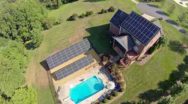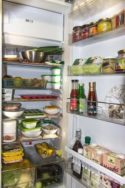
Love those Tesla-lovers
Jason Hughes is a happy hacker – but not of computers – he is known for leaking Tesla’s plans ahead of the company’s actual announcements, and now he has revealed photos of his own Tesla battery-powered compound in North Carolina. The 4,500 square-foot home has 102 commercial-grade solar panels to capture energy from the sun which then gets stored into a home battery storage unit composed of battery modules ripped from two Tesla Model S 85 kWh packs.
The 44.4 kW home solar system produces enough energy to not only power the entire home and all of its electrical appliances, but also provides enough energy to charge a pair of his and hers Model S each day. The end result is an elaborate home-engineered system that took roughly a year to design and build, and has allowed Hughes and his family to remain 99% self-sufficient for the past two years.
The battery banks used for storing solar energy are derived from*battery packs found from a salvaged Model S. Hughes dismantled the packs to create a stacked array of battery modules. A total of 36 modules are used in the home set up which equates to 2.25x Model S 85 kWh battery packs.
Here’s a video of Hughes performing a teardown of one of the Model S battery packs.
hughes-solar-home-electrical-roomhughes-solar-home-tesla-battery-module-2hughes-solar-home-tesla-battery
COSTS OF SOLAR POWER
Hughes says a large portion of the overall expenditure went to the $40k cost in Tesla batteries. He admits that the project likely doesn’t make sense from a financial perspective, but it’s important to understand that the value of his project goes beyond what a cost benefit analysis may yield.
Beyond being able to show that living solely off of sustainable energy is possible, the main inspiration behind his yearlong project was his father who taught him at a young age of 9 how to build a small off-grid solar system that produced enough energy to power his bedroom light, a small TV and a PC. That became the catalyst to what would become a lifelong dream to design an off-grid system capable of powering an entire house, along with electric vehicles.
HOME SOLAR SYSTEM WITH TESLA BATTERY
36 modules from 2.25x Tesla 85kWh packs
191.25 kWh (DC side)
~4,200 Ah
43.2V nominal @ 3.6V per cell
15,984 cells (!)
Inverters: 8x Outback Radian GS8048A
240VAC @ 60Hz w/neutral
64kW continuous AC output
30 minute surge: 72kW; 5 second surge: 96kW; 100ms surge: 135.76kW
Grid-Battery Charging Capacity: 57kW
Expected AC output from pack after safe SoC window and efficiency considerations: ~160 kWh usable AC power
PV: 102 Sunpower Commercial Panels @ 435W (20% efficiency) for 44,370 Watts DC
Split into 17 sets of 6 panels (3 parallel of 2 in series)
17 individual MPPT charge controllers (Midnite Solar Classic 200)…

